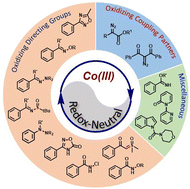Redox-neutral C–H annulation strategies for the synthesis of heterocycles via high-valent Cp*Co(iii) catalysis
Abstract
A variety of biologically active molecules, pharmaceuticals, and natural products consist of a nitrogen-containing heterocyclic backbone. The majority of them are isoquinolones, indoles, isoquinolines, etc.; thereby the synthesis and derivatization of such heterocycles are synthetically very relevant. Also, certain naphthol derivatives have high synthetic utility as agrochemicals and in dye industries. Previous approaches have utilized ruthenium, rhodium, or iridium which may not be desirable due to the high toxicity, low abundance, and high cost of such 4d and 5d metals. Moreover, the need for an external oxidant during the reaction also adds by-products to the system. A high-valent cobalt-catalyzed redox-neutral C–H functionalization strategy has emerged to be a far better alternative in this regard. The use of the non-noble metal cobalt allows for selectivity and specificity in product formation. Also, the redox-neutral concept avoids the use of an external oxidant either due to the presence of a metal in a non-variable oxidation state throughout the catalytic cycle or due to the presence of an oxidizing directing group or an oxidizing coupling partner. Such an oxidizing directing group not only directs the catalyst to a specific reaction site by chelation but also regenerates the catalyst at the end of the cycle. Certain bonds such as N–O, N–N, N–Cl, N–S, and C–S are the main game-players behind the oxidizing property of such directing groups. In the other case, the directing group only chelates the catalyst to a reaction center, whereas the oxidation is carried out by the upcoming group/coupling partner. Overall, merging the redox-neutral concept with the high-valent cobalt catalysis is paving the way forward toward a sustainable and environmentally friendly approach. This review critically describes the mechanistic understanding, scope, limitations, and synthesis of various biologically relevant heterocycles via the redox-neutral concept in the high-valent Cp*Co(III)-catalyzed C–H functionalization chemistry domain.



 Please wait while we load your content...
Please wait while we load your content...